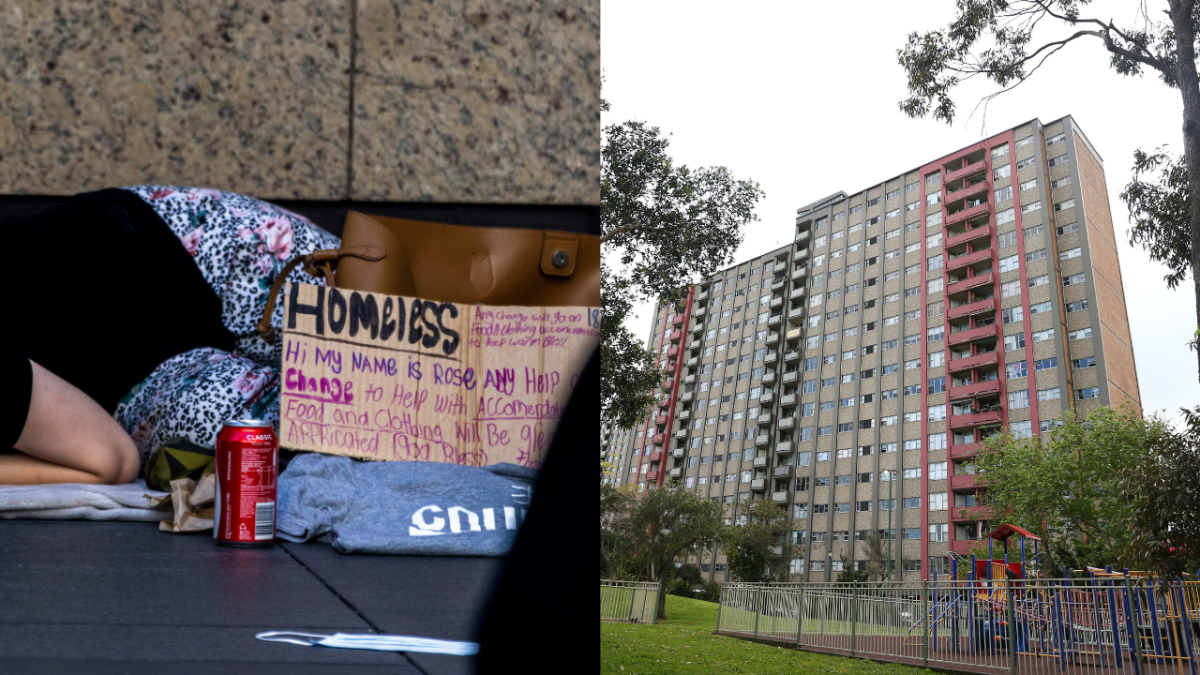
Homelessness in New South Wales has increased 10 per cent since the pandemic began, a shocking report released on Monday found. Meanwhile, rents are skyrocketing and rental vacancy has plummeted which has made it increasingly difficult and distressing to find a stable home.
The Aftershock report was published by Impact Economics and Policy and commissioned by the NSW Council Of Social Service (NCOSS), Community Housing Industry Association (CHIA) NSW, Aboriginal Community Housing Industry Association (ACHIA) and Homelessness NSW.
It found 3,700 more people are homeless in NSW today compared to the start of 2020 and, in the same time frame, as many as 54,000 households have experienced increased housing stress.
“The past two years of major disruptions brought by fires, floods and the pandemic have exposed the underlying failures of housing policy in NSW and across Australia,” NCOSS CEO Joanna Quilty said.
Quilty said the housing and rental crisis was a “disgrace” nationwide but the situation was particularly dire in NSW.
Domain’s Chief of Research and Economics Dr Nicola Powell told PEDESTRIAN.TV rising rents and record-low rental vacancy rates were connected to rising homelessness in NSW.
“When you’ve got escalating rents and you’ve also got increasing cost of living, it becomes very challenging for lower-income households, and that does feed into the stats around increased homelessness,” Powell said.
Domain’s latest Quarterly Rent Report released on Thursday found Sydney house rents jumped by 4.8 per cent during the September quarter to a new record high of $650 a week on average. It’s the second-largest quarterly rise on record.
Unit and apartment rents also rose 4.8 per cent in the last three months to reach an average of $550 a week. Units have seen the steepest annual rise on record in the last 12 months at 14.6 per cent.
Powell explained the rising unit price was particularly concerning because although house rents have been smashing record highs for some time, unit rents were actually declining before and during the pandemic.
“It’s such a poignant time that they’re back up at that record high of $550 a week now because it means they’ve recouped all they lost,” she said.
“It really highlights not only the affordability issue … but also how strained the rental market is that both property types are at record highs. For someone on a lower income, that is extremely hard to keep up with when you’re competing with somebody in a rental market who has a higher income.”
Powell said people were already making compromises on location, rental type and even housing arrangement, meaning more people are opting for sharehouses or similar arrangements amid record-low availability. Sydney currently has a rental vacancy rate of 0.6 per cent — down 55 per cent from this time last year.
“We haven’t built enough social housing, that means there are some people who are pushed into the private market who should really be in social housing,” she said.
“They’re our most vulnerable Australians and they are vulnerable to homelessness.”
The crisis has escalated so much this year we may have reached a tipping point.
ACHIA CEO Lisa Sampson said the homelessness rate going up in NSW was “absolutely the opposite” of what people working in the space wanted to see.
“It’s painful to have to see this,” Sampson told PEDESTRIAN.TV.
“The prolonged effects of the pandemic, particularly in remote communities, is part of what’s pushing that rise in homelessness [and] a decrease in government investment is clearly a factor but it can’t be underestimated that there is an interplay of other factors.”
The Aftershock report found Aboriginal and Torres Strait Islander peoples were way overrepresented in NSW’s homeless population. Almost 30 per cent of clients of NSW homelessness services in the last two years were First Nations, but they represent just 3.4 per cent of the state’s population.
“I appreciate that there’s rising homelessness and rising housing stress across many sections of Australian society, but when you look at the intergenerational disadvantage that’s arisen out of intergenerational trauma … Aboriginal people experience double, triple, quadruple disadvantage,” Sampson said.
Sampson said there were many reasons First Nations people may experience homelessness, including over-incarceration, children previously fostered ageing out at 18, and exploitation in the workforce leading to lower employment rates or wage theft. But beneath that, she said First Nations people had always been starting behind non-Indigenous Australia.
“Not being able to build up an estate to leave your kids, not having a stable home base from which to embark on a university career as much of middle Australia has done… It’s not about equality, it’s about equity. How do we build a system to ‘leapfrog’ Aboriginal people forward so they’re at least at the starting line?”
Increasing homelessness is estimated to cost the NSW economy between $524.5 million and $2.5 billion over six years, according to the Aftershock report.
It also contained several recommendations to the NSW Government to start to turn these numbers around. They included building an additional 5,000 social housing units annually, implementing stamp duty reform and tenancy rights reform and committing to an increase in rental assistance.
A spokesperson for the NSW Department of Planning and Environment told PEDESTRIAN.TV boosting social housing was a government priority.
“Over the next four years we are investing $554.1 million to fast-track the delivery of new and upgraded homes for both social and Aboriginal housing,” they said.
“This includes five projects to deliver 1,300 new social and affordable homes for the Sydney CBD in Glebe, Redfern and Waterloo.”
But these targets are well below what’s needed and with rent prices and the cost of living suffering dramatic increases month-on-month, more drastic action may be needed to make any meaningful difference.
“It takes time for houses to be built,” Powell said.
“But [we need to be] increasing rental assistance, building more social housing and helping tenants transition to becoming homeowners.”



